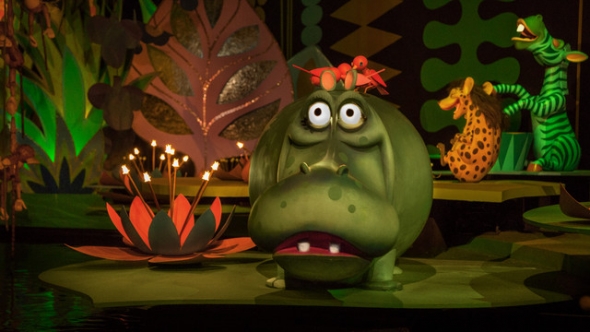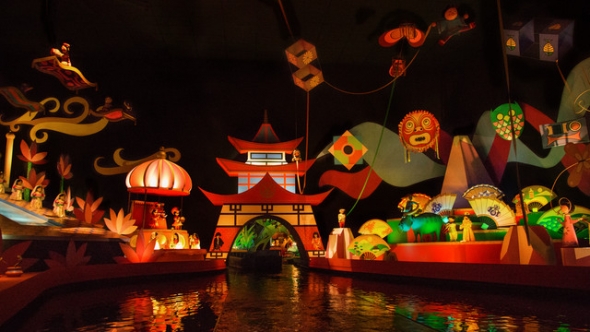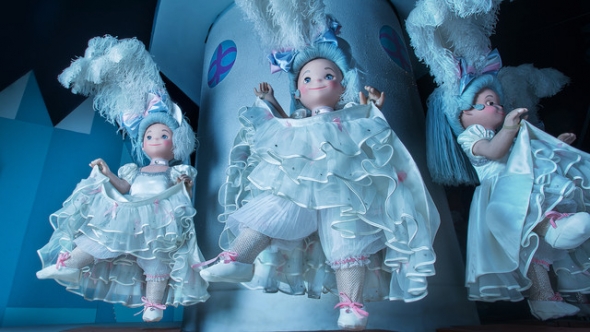The experience: Transitioning a pavilion to its permanent home
The trick: Pixie dust from Uncle Walt himself
Image: Disney
The backstory of It’s a Small World is every bit as amazing as its popularity and longevity. During the early 1960s, lots of corporations and other enterprises including state governments engaged in an arms race. The ultimate goal was to build the most impressive pavilion at the 1964 World’s Fair, a massive event at the time. Many of these industrialists tried to broker deals with Walt Disney and his famous Imagineers at WED Enterprises.
A shrewd businessman, Disney understood that he held all the power in negotiations. So, he persuaded a trio of organizations including Ford Motors, General Electric, and the state of Illinois to agree to his terms. In exchange, he built unforgettable and lasting attractions like The Carousel of Progress, Great Moments with Mr. Lincoln (the genesis of the Hall of Presidents), and a third one that was a last minute addition.
Pepsi Cola had little luck in getting their World’s Fair pavilion off the ground. Desperate, they listened to one of their board members, actress Joan Crawford. She recommended that they do whatever was needed to persuade Disney and his team to construct their pavilion. They agreed.
Image: Disney
It’s a Small World was an immediate hit, and after the following year's World’s Fair ended in 1965, Pepsi Cola owed Disney and his team a great deal of money. Cleverly, the entrepreneur agreed to lower the cost of payment on one condition: they had to pay to transport the entire attraction to Disneyland, where it would take up permanent residence.
Uncle Walt capitalized on the pop culture awareness of the 1964 World’s Fair, marketing one of his pavilions on Pepsi Cola’s dime. Then, he again got them to foot the bill in relocating it to his storied theme park, where it quickly became one of the most popular attractions. It’s a Small World was already in operation at Disneyland by May of 1966, barely seven months after the World’s Fair ended. Some of the items transported from New York famously still have the 1965 shipping stickers on them.
Disney earns a lot of positive press these days for their acquisitions of Pixar, Marvel, and Star Wars on the cheap. What the company founder accomplished with It’s a Small World rivals all of these business deals.
The experience: A trip around the world in 15 minutes
The trick: Building the proverbial “little boat ride” that Uncle Walt had envisioned
Today, everyone’s familiar with the Omnimover as a concept. A series of connected ride carts move at a set speed along a conveyor belt. It’s a ride cart system that offers benefits to the person in the vehicle as well as those operating it. Via the omnimover, a theme park attraction will position the rider precisely where they need to be to enjoy the spectacle. While you’re enjoying the ride, the park employees know exactly where you are and how long you’ll take.
Disney and their successors employ Omnimovers as a way to control throughput AND rider safety. Your ride cart is on rails the whole time, both pushing along to the next waypoint and guaranteeing that you don’t stray off the course into more dangerous areas strewn with mechanical moving parts. Simply stated, the Omnimover is THE most important innovation in theme park history. And its roots trace back to the development of what Walt Disney described as a “little boat ride.” You’ll soon discover that It’s a Small World isn’t an Omnimover attraction, though!
When one of New York’s most famous urban planners, Robert Moses, implored Walt Disney to construct a “children’s village,” the leader of WED Enterprises ran with the idea. He expanded the request, building a world village instead. Each section would reflect a specific culture, and the only way such an offering was feasible was by controlling the speed of movement of pavilion visitors. Disney designed an entirely new ride system for the boats that would float down the man-made waterways of It’s a Small World.
Image: Disney
You may not realize this, but the original version of the Omnimover came with wheels. Legendary Imagineer Rolly Crump illustrated mock-ups of the boats. He later recounted, “We would put Walt on a boat that was on wheels and that was elevated to the right sightline, and then push him through the ride.” Disney wanted to tell a story similar to a motion picture, which was their default thought process. The Omnimover allowed them to do this; however, It’s a Small World didn’t have one at the time. Instead, it was the forerunner of the technology.
Disney built the equivalent of aqueducts for It’s a Small World. Since they enclosed the space and thereby confined the boats to a linear path, the voyagers on the “little boat ride” were on a one way ride downstream. Imagineers loved this idea so much that they explored it further, eventually finalizing the premise of joined vehicle carts with the now defunct Adventures Thru Inner Space, which debuted in 1967. That’s the takeaway about It’s a Small World. Since the boats aren’t connected together to keep the chains moving, so to speak, it’s not an Omnimover.




Add new comment